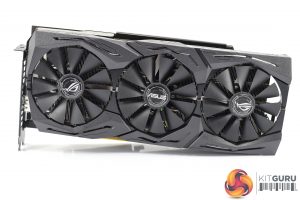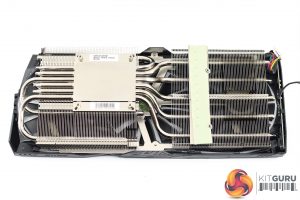The ASUS ROG RTX 2060 Strix OC ships in a a very familiar-looking box – the ROG logo is printed in bright neon colours, with an image of the card itself positioned on the left hand side of the box.
There isn't a whole lot in the way of accessories, as inside we find a quick start guide, a driver disk and then two Velcro cable ties.
Getting our first look at the card, it is an immediately familiar design – having already reviewed the Strix 2080 and 2080 Ti cards, all three share the same matte black shroud and each come with triple fan cooling configurations.
That being said, this Strix 2060 arguably looks more like the previous gen Strix GTX 1080 Ti. That's because, unlike the 2080 and 2080 Ti Strix models, this 2060 uses ASUS' older ‘wing blade' fans, when the newer models use the ‘axial-tech fans' which sport those rings running around the edge of the fans.
We asked ASUS why they made this decision, and were told that the fan design is ‘dictated by the needs of the GPU' – essentially suggesting that the 2060 is a much easier chip to cool than a 2080, for instance, thus ASUS doesn't need to use the presumably more expensive axial-tech fans to ensure good temperatures.
Despite the Founders 2060 being quite a compact card, ASUS has gone the opposite direction and in typical Strix fashion this card is huge. That's because it measures 30.00 x 13.20 x 5.00 cm – making it over 7cm longer than the Founders Edition.
As a 2.5-slot card, though, it is not quite as thick as the other Strix 20-series cards we have seen – those are 2.7-slot cards, but regardless you will need a big case to ensure this 2060 will fit.
Opening the card up is as simple as removing six screws from the backplate. Then we get a look at the PCB and the metal frame that is actually screwed onto the PCB to improve structural rigidity as well as cool the six GDRR6 memory chips. Removing that is a simple case of unscrewing the frame from the backplate and I/O bracket.
With that out of the way, there are a few things worth pointing out about the PCB. The first is the beefed up power delivery which comprises 8+2 power phases – up from 6+2 with the Founders 2060. On top of that, we can see that the TU106 GPU that ASUS is using here is indeed a binned chip – it is labelled ‘TU106-200A', and it is the ‘A' which denotes this GPU can be sold with a factory overclock.
Elsewhere, the 6GB GDDR6 memory is also worth noting – this is from Micron and the chips are labelled ‘DTA77D9WCW'. At the end of the PCB, we find an additional three 4-pin headers. Two of these are PWM fan headers which will control your system fans based on the graphic card's temperature instead of your CPU's temperature. The other header is a 4-pin ASUS Aura RGB connector which will let you plug in additional RGB devices to the graphics card itself.
As for the heatsink, this is a hefty unit with a total of 6 heatpipes, with each measuring 6mm in diameter. These feed through a chunky fin array, while the GPU die contacts with a coldplate. This uses ASUS MaxContact technology, which the company says allows it to be up to 10x flatter than other coldplates, ensuring greater contact between the GPU die and the metal – thus ensuring greater thermal transfer. We test thermal performance later in the review.
On the front side of the card, we can note the ‘GeForce RTX' branding which is printed onto the metal frame we mentioned earlier. Just above that, however, we also find a dual-BIOS switch – as with other Strix cards from this generation, this lets users choose between the ‘performance’ BIOS or the ‘quiet’ BIOS. The only change is the fan curve is drastically reduced when using the card with its quiet BIOS, as clock speed remains the same. This is something we test later in the review.
In terms of the backplate, this is the same brushed metal design we have seen before from ASUS, with the owl eye logo on the right hand side also acting as one of the card's RGB zones. There is also a master power button for the RGB lighting positioned just to the right of the dual-BIOS switch, and a press of this turns all the lighting on or off.
Other things to mention include the 1x 8-pin and 1x 6-pin PCIe power requirements. and of course we test power consumption later in the review.
Lastly, display outputs consist of 2x DisplayPort 1.4 and 2x HDMI 2.0b, but no DVI or USB-C connectors.
 KitGuru KitGuru.net – Tech News | Hardware News | Hardware Reviews | IOS | Mobile | Gaming | Graphics Cards
KitGuru KitGuru.net – Tech News | Hardware News | Hardware Reviews | IOS | Mobile | Gaming | Graphics Cards




















